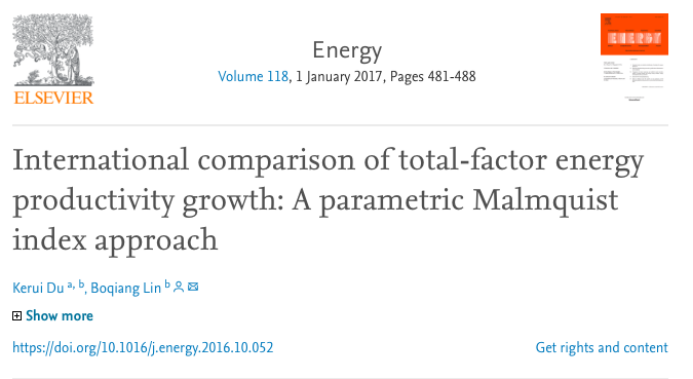
题目:全要素能源生产率增长的国际比较:参数Malmquist指数方法(International comparison of total-factor energy productivity growth: A parametric Malmquist index approach)
作者:杜克锐,林伯强*
期刊:能源(Energy)
详细:第118卷,2017年1月1日,第481-488页
DOI:https://doi.org/10.1016/j.energy.2016.10.052
文献导读:
工业革命带动了世界能源消费的增长。特别是20世纪中期以后,工业生产的迅速扩张导致能源消耗显著增长,这给人类社会的可持续发展带来了一些挑战。一方面,化石能源已经被过度开发导致其已经开始枯竭。另一方面,能源的过度消耗导致了一系列的环境问题。提高能源利用效率被广泛认为是解决这些问题的最经济有效的措施之一。
本文旨在比较过去几十年间世界123个经济体的能源生产率增长情况。为此,本文构建了基于Shephard能源距离函数的Malmquist能源生产率指数来测度全要素能源生产率的变化。我们使用一个考虑个体的异质性和统计噪声的固定效应SFA模型来估计这个指数。
相比于现有文献,本文贡献主要有以下三点:首先,以往的研究主要集中在对某些特定国家/地区的全要素能源效率的测度,很少有研究关注国际经济体的全要素能源生产率的动态变化。本文试图弥补以上不足。其次,考虑到宏观经济数据中存在的统计噪声,本文引入了参数化的Malmquist指数方法。第三,世界经济体的发展不平衡表明个体间存在异质性。为了解释个体异质性,现有文献广泛使用meta前沿分析方法,该方法需要根据一些先验信息对样本进行分割。因此,该方法存在一些潜在的问题。例如,由于个体的异质性通常是不可观察的,先验信息可能不可靠,从而导致估计结果的偏差;不同的样本划分方法会产生不同的实证结果;它没有充分利用样本不同子组之间的公共信息。鉴于此局限性,本文采用新开发的固定效应SFA估计量来解决这个问题。
Abstract:
This paper constructs a Malmquist energy productivity index based on the Shephard energy distance function to measure total-factor energy productivity change. In order to account for individual heterogeneities as well as statistical noises, we use a newly developed fixed-effects SFA model for estimation. Then it is applied to compare energy productivity growth across the world's 123 economies. The main findings are as follows. First, on average the world witnessed a 34.6% growth of energy productivity between 1990 and 2010 which was mainly driven by technological progress. Second, the developed countries achieved higher growth in energy productivity than the developing countries. Third, the developed countries took lead in technological progress while the developing countries performed better in efficiency improvement. Fourth, there are no evidences supporting ơ-convergence among countries' energy productivity growth.
Keywords: Energy efficiency; Energy productivity; Fixed-effects; SFA
 厦大总机:0592-2180000
|
地址:福建省厦门市思明区思明南路422号
|
邮政编码:361005
厦大总机:0592-2180000
|
地址:福建省厦门市思明区思明南路422号
|
邮政编码:361005